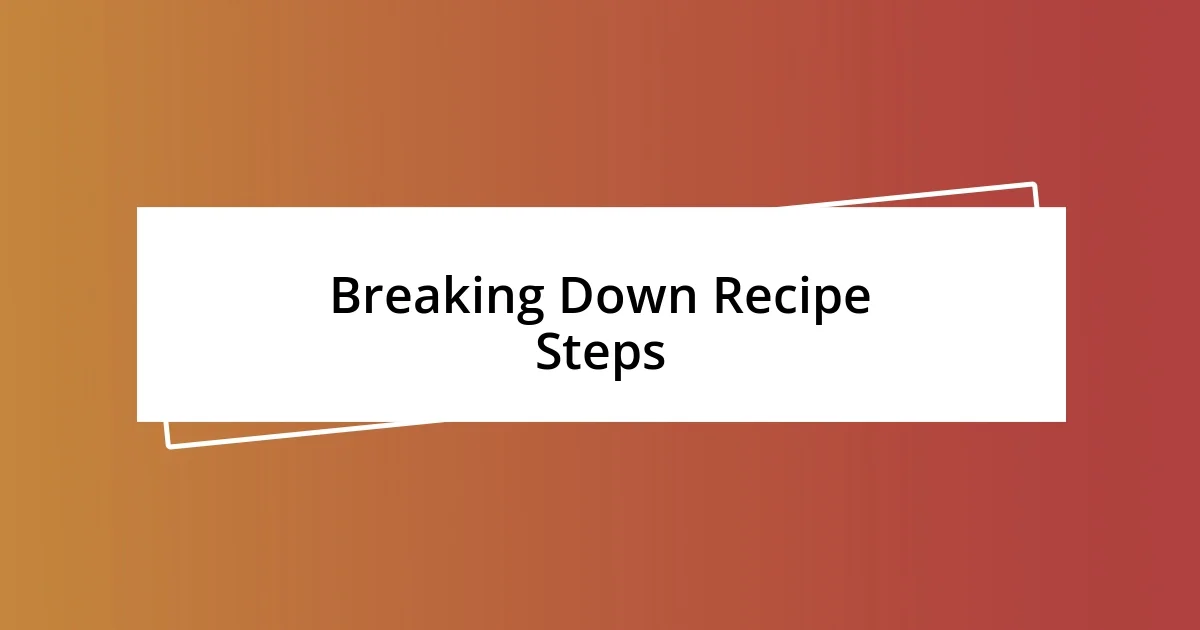Key takeaways:
- Understanding personal learning styles (visual, auditory, kinesthetic) enhances the ability to master new recipes effectively.
- Organizing recipes by categorization, rating, and regular updates streamlines cooking and inspires confidence in culinary skills.
- Tracking progress through a cooking journal and visual documentation fosters growth and motivation in the culinary journey.

Understanding Your Learning Style
Understanding your learning style is crucial for mastering new recipes effectively. I remember the first time I tried to follow a written recipe—it felt overwhelming. I’d get lost in the jargon and forget steps because I was a visual learner, struggling to translate printed instructions into a practical dish. Have you ever felt that frustration when a recipe just doesn’t seem to click with how you learn?
Different learning styles can greatly influence how we approach cooking. For instance, when I switched to watching cooking videos instead of reading recipes, everything changed. I could see the technique in action, which made it easier to replicate the skills in my own kitchen. What about you? Do you prefer hands-on practice, or do you enjoy reading and analyzing each recipe before diving in?
Recognizing whether you are a visual, auditory, or kinesthetic learner will help you choose the best way to absorb information. Personally, I find that cooking alongside a friend who explains their process makes learning feel more dynamic. Have you tried cooking with others who share their methods? It can turn a recipe into a fun, collaborative experience that enriches your culinary skills!

Selecting Recipes to Learn
Selecting recipes can be an exciting yet daunting task. I often find myself browsing through cookbooks or apps, looking for something that not only catches my eye but also aligns with my current skill level. There’s a thrill in experimenting with a complex dish, but it’s equally important to select recipes that build my confidence. Have you ever jumped into a recipe that was way beyond your current skills? It can quickly become discouraging if you’re not careful.
Sometimes, I focus on seasonal ingredients to guide my recipe selections. For instance, during fall, I gravitate towards squash and root vegetables, which inspire warm, hearty meals. I remember making a butternut squash soup for the first time. It was simple yet satisfying, and it encouraged me to try more seasonal soups, ultimately broadening my cooking repertoire. Do you ever let the time of year dictate what you cook? It’s a fantastic way to stay connected to the seasons.
Another strategy I use is considering the occasion or the people I’ll be cooking for. When hosting friends, I tend to opt for recipes that are festive and communal, like paella or a large pasta dish. These meals not only create a vibrant atmosphere but also allow me to share my excitement for cooking. Have you noticed how certain recipes can turn a simple gathering into a memorable event? Choosing recipes that fit the mood or occasion definitely enhances the overall experience.
| Factors | Considerations |
|---|---|
| Skill Level | Select recipes that match your current cooking abilities to enhance confidence. |
| Seasonality | Choose ingredients that are in season for fresh and flavorful dishes. |
| Occasion | Think about who you are cooking for and pick recipes that enhance the event. |

Organizing Your Recipe Collection
Organizing Your Recipe Collection
When it comes to organizing my recipe collection, I’ve found that a systematic approach saves me a lot of time and headaches. I started with a digital format because I love having everything at my fingertips, especially when I’m in a cooking groove. Creating digital folders by category—like appetizers, mains, and desserts—has made searching for a recipe so much easier. I remember the frustration of rifling through endless stacks of papers to find that perfect chocolate cake recipe; now, it’s just a quick search away. Do you have a system that works for you, or is it more of a chaotic adventure each time you cook?
- Categorization: Group recipes by type or cuisine for easy access.
- Rating System: Use stars or notes to highlight your favorites or those that need improvement.
- Recipe Source: Keep track of where you found each recipe, especially if you want to revisit it or recommend it to someone else.
- Regular Updates: Set aside a day each season to review and refresh your collection, removing recipes that no longer inspire you.
I’ve also started creating a recipe journal where I jot down modifications and outcomes for each dish I try. This practice not only keeps my collection organized but also helps me document my culinary journey. It feels rewarding to look back and see how far I’ve come! Have you ever thought about keeping a personal record of your cooking adventures? It adds a layer of richness to your experience and can spark joy as you see your growth over time.

Breaking Down Recipe Steps
Breaking down recipe steps is essential for effective cooking. I’ve learned that reading through a recipe several times before starting can clarify the process. For instance, when I first attempted a homemade bread recipe, I found it a bit overwhelming. But by outlining each step—mixing, kneading, rising, and baking—I learned to focus on one task at a time, which made it much more manageable. Have you ever noticed how demystifying the process can spark your enthusiasm?
Another technique I utilize involves breaking steps into smaller, actionable tasks. Instead of viewing a recipe as a whole, I categorize it by prep, cook, and finish. I remember tackling a complicated lasagna; instead of dreading the layers, I prepped the fillings and sauces the day before. This approach transformed what seemed like an intimidating process into a series of enjoyable activities. Do you find that chunking tasks into smaller bits makes cooking feel less daunting?
I also make it a habit to visualize the dish as I work through the steps. Imagining the colors and smells helps heighten my engagement with the recipe. For example, while preparing a vibrant vegetable stir-fry, picturing each crisp ingredient sizzling in the pan always excites me. This mental imagery not only enhances my cooking experience but also encourages me to pay close attention to the details. Have you ever thought about how imagining the final dish can elevate your cooking journey?

Practicing Techniques and Skills
When it comes to honing my cooking techniques, I’ve found that practice truly makes perfect. For instance, I dedicated a weekend to mastering knife skills, slicing various ingredients to see how technique affects texture and presentation. It was rewarding to feel my confidence grow with each chop; have you ever noticed how satisfying it is to see improvement in something you love?
Repetition can take a dish from mediocre to extraordinary. I remember the first time I tried my hand at making an omelet; it ended up more like scrambled eggs! But after numerous attempts, analyzing what went wrong each time, I finally achieved that fluffy, perfectly folded result. Each failed attempt been a lesson, reminding me that every cook has their mishaps—what’s your favorite cooking blunder that turned into a learning moment?
Experimentation is also key to refining my culinary skills. One evening, I decided to tackle caramelizing onions—a seemingly simple task that I always avoided. I learned through trial and error how different heat levels and timings produced varying sweetness and color. Watching those onions transform was mesmerizing! I can’t help but wonder, what techniques have you been hesitant to try that could lead to delicious discoveries?

Tracking Your Progress
Tracking my progress in the kitchen has become not just a method, but a rewarding journey. I like to keep a cooking journal where I jot down my experiences with each new recipe I try. For instance, after making a complex curry, I noted the adjustments I made to the spices, which flavors worked well, and what I might try differently next time. It’s fascinating how writing things down can solidify my memories and insights. Have you ever considered how reflecting on your cooking adventures might help you grow?
I also find that taking photos of my completed dishes serves as a visual progress tracker. There’s something incredibly satisfying about looking back at my culinary evolution through images. When I compare the clumsy plating of my first attempts to the beautifully arranged dishes I create now, it sparks a sense of pride. Have you captured your cooking milestones this way?
To further enhance my learning, I’ve set specific goals for each recipe I tackle. One week, I aimed to perfect baking desserts; I committed to trying a new treat every Saturday. Unearthing my success with a delicate soufflé after weeks of working on my baking skills was exhilarating! Tracking my progress in this way truly keeps me motivated and allows me to celebrate each victory. What goals have you set for your cooking journey?














